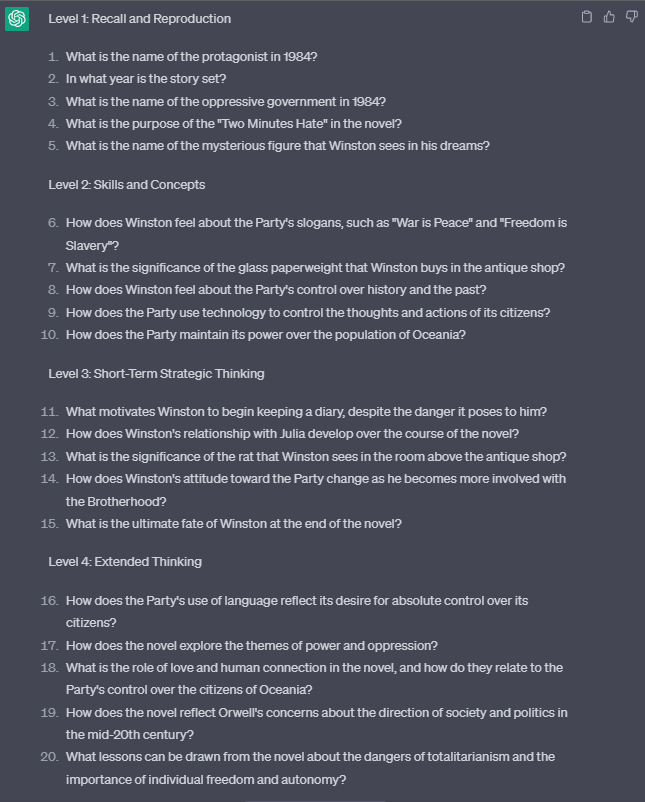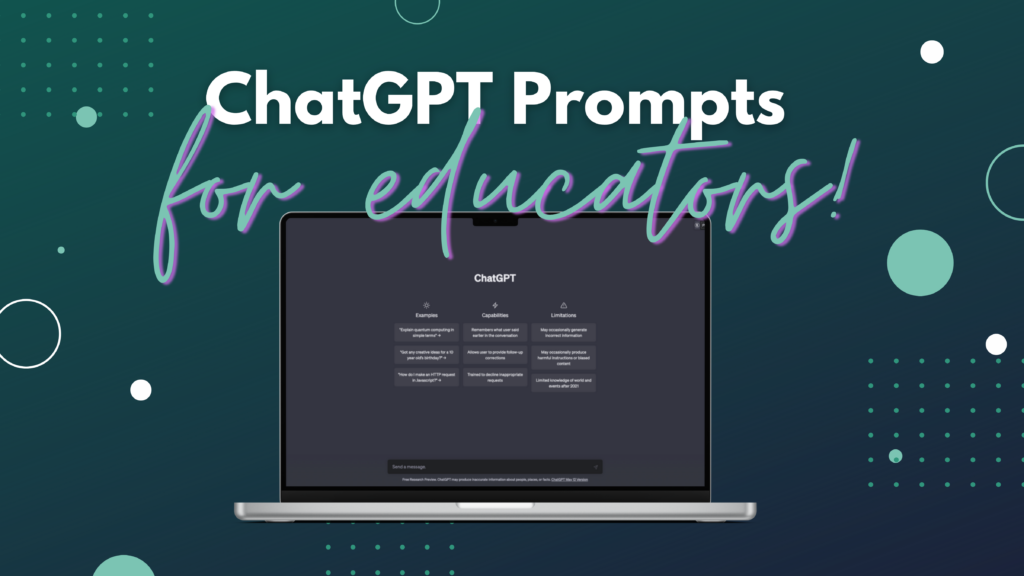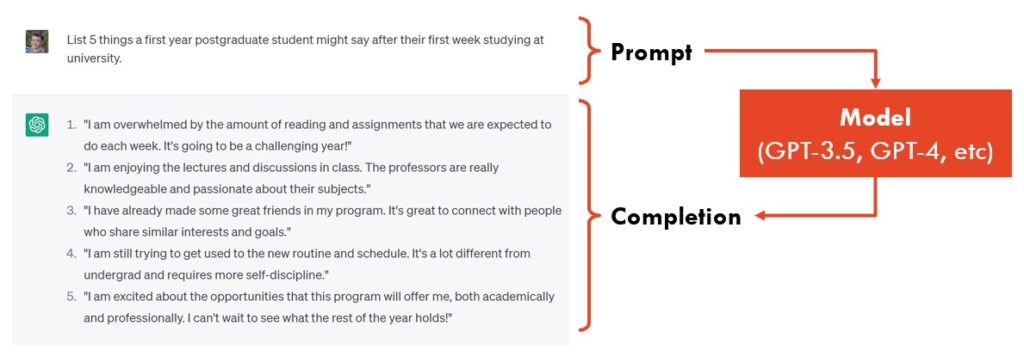In the exciting world of education, incorporating technology has become increasingly important. That’s why we’re here to introduce you to the concept of AI prompts for education. In our upcoming blog post titled ‘Powerful ChatGPT Prompts for Teachers,’ we are going to explore how ChatGPT, an AI language model, can revolutionize the way teachers engage with their students. This article is tailored specifically for educators, providing carefully curated prompts that leverage the power of AI to enhance teaching methods, foster interactive learning environments, and ignite creativity. Whether you’re a seasoned educator or new to the profession, this guide will equip you with innovative ways to integrate ChatGPT into your teaching toolkit, making education an even more exciting journey for both you and your students. So, get ready to unlock the transformative potential of AI in education with our ChatGPT prompts for teachers!

Introduction to AI in Education
AI, or Artificial Intelligence, has revolutionized various industries, and the field of education is no exception. With its ability to analyze vast amounts of data, identify patterns, and make informed decisions, AI has the potential to enhance learning experiences, personalize education, and improve teacher efficiency. In this comprehensive article, we will explore the benefits of AI in education, such as improved learning experiences, personalized learning, enhanced teacher efficiency, and greater accessibility and inclusivity. Furthermore, we will discuss the various applications of AI in education, including AI-powered virtual assistants, content creation, tutoring systems, and grading and assessment. We will also delve into ethical considerations and challenges related to AI in education, as well as integration strategies, tips, and best practices for using AI, specifically ChatGPT, in the classroom. Lastly, we will explore future possibilities and innovations, such as AI-powered virtual reality, collaborative learning mediated by AI, and predictive analytics for student success.
Benefits of AI in Education
Improved Learning Experiences
AI has the capacity to enhance learning experiences by providing students with personalized and adaptive learning opportunities. By analyzing student data and understanding their strengths and weaknesses, AI algorithms can tailor content and resources to meet individual needs. This ensures that students receive a more engaging and effective learning experience, allowing them to progress at their own pace and explore their interests.
Personalized Learning
In a traditional classroom setting, it can be challenging for teachers to cater to the unique needs of each student. However, AI-powered systems can analyze vast amounts of data and create personalized learning paths for students. Adaptive learning algorithms can identify areas where students need additional support and offer targeted resources and exercises to help them improve. This personalized approach not only boosts student engagement and motivation but also maximizes their learning outcomes.
Enhanced Teacher Efficiency
AI can assist teachers in automating administrative tasks, such as grading assignments and managing classroom logistics. By taking care of time-consuming and repetitive tasks, AI allows teachers to focus more on designing engaging lessons, providing individualized instruction, and building strong relationships with students. This increases overall teacher efficiency and productivity, creating a conducive learning environment for students.
Greater Accessibility and Inclusivity
AI has the potential to promote greater accessibility and inclusivity in education. By leveraging AI technologies, educational institutions can reach students who may face barriers to learning due to physical disabilities, geographical constraints, or socio-economic challenges. AI-powered tools can provide additional support to students with special needs, offer real-time translations for non-native speakers, and ensure that educational resources are available to a diverse range of learners, thus fostering a more inclusive learning environment.

AI-Powered Virtual Assistants
Automated Administrative Tasks
AI-powered virtual assistants can streamline administrative tasks for educators, saving time and effort. These intelligent assistants can handle activities such as scheduling, data management, and organizing classroom resources. By automating these mundane tasks, virtual assistants free up teachers’ time, allowing them to focus on more important aspects of their work, such as lesson planning and providing personalized instruction.
Answering Student Questions
AI-powered virtual assistants can provide instant and accurate answers to students’ questions. Using natural language processing and information retrieval techniques, these assistants can understand and respond to queries from students, eliminating the need for them to wait for a teacher’s availability. This not only encourages independent learning but also provides students with immediate support and feedback.
Providing Real-Time Feedback
AI-powered virtual assistants can also offer real-time feedback to students, enabling them to monitor their progress and make necessary improvements. Through the analysis of student work, virtual assistants can provide constructive feedback, highlight areas of strength, and suggest specific strategies for improvement. This personalized feedback helps students gain a deeper understanding of their learning and fosters a growth mindset.
AI-Powered Content Creation
Automated Lesson Plans
AI-powered systems can generate automated lesson plans based on curriculum guidelines and educational objectives. By analyzing educational content, these systems can identify relevant resources, activities, and assessments, and compile them into comprehensive lesson plans. This can save teachers valuable time and provide them with a solid foundation to build upon, ensuring that their lessons align with educational standards.
Generating Interactive Learning Materials
AI can be utilized to generate interactive learning materials that cater to different learning styles and engage students in active participation. These materials can include videos, simulations, interactive quizzes, and virtual reality experiences. By incorporating AI-generated interactive learning materials into their classrooms, teachers can create a more dynamic and immersive learning environment that motivates students and enhances their understanding of complex concepts.
Creating Personalized Assessments
AI-powered systems can create personalized assessments that adapt to students’ individual learning needs. By analyzing student performance data, these systems can generate assessments that cater to each student’s strengths and areas for improvement. This allows for a more accurate evaluation of student progress and provides teachers with valuable insights to inform their instruction.

AI-Powered Tutoring Systems
Adaptive Learning Pathways
AI-powered tutoring systems can provide adaptive learning pathways for students, guiding them through personalized learning journeys. These systems analyze student data, identify areas where students need support, and offer targeted learning materials and activities. By adjusting the content and pace of instruction to meet individual needs, AI-powered tutoring systems can help students achieve their learning goals effectively.
Individualized Instruction
AI can facilitate individualized instruction by providing personalized feedback, recommendations, and resources to students. Through sophisticated algorithms and machine learning techniques, AI-powered tutoring systems can understand individual learning preferences and adapt instructional strategies accordingly. This level of personalization ensures that students receive tailored support and enrichment, leading to improved learning outcomes.
Tracking Student Progress
AI-powered tutoring systems can track and analyze student progress in real-time, providing teachers with insights into each student’s performance. By monitoring their progress, teachers can identify learning gaps, areas of strength, and areas that require additional support. This data-driven approach enables teachers to make informed instructional decisions and offer timely interventions to ensure student success.
AI-Powered Grading and Assessment
Automated Grading
AI can automate the grading process, saving teachers significant time and effort. By using machine learning algorithms, AI-powered grading systems can analyze student responses and assign scores or feedback. This eliminates the need for teachers to manually grade large volumes of assignments, allowing them to focus on providing more meaningful and personalized feedback to students.
Efficient Feedback Generation
AI-powered grading systems can provide efficient and timely feedback to students. These systems can not only identify correct and incorrect answers but also offer explanations and additional resources to support students’ learning. By providing instant feedback, AI-powered grading systems enable students to reflect on their performance, understand their mistakes, and make improvements in a timely manner.
Identifying Learning Gaps
AI-powered grading and assessment systems can identify learning gaps and areas where students may be struggling. By analyzing student performance across various assessments, these systems can pinpoint areas that require additional instruction or reinforcement. This data-driven approach allows teachers to tailor their instruction to address specific learning needs and ensure that students are adequately prepared for future learning.

Ethical Considerations and Challenges
Data Privacy and Security
One of the primary ethical considerations in AI-powered education is the protection of student data privacy and security. Educational institutions must ensure that student data is collected, stored, and used responsibly and in compliance with relevant regulations. It is essential to implement secure data storage and transmission practices, obtain appropriate consent for data usage, and protect student information from unauthorized access.
Bias and Discrimination
AI systems can inadvertently perpetuate bias and discrimination if not properly designed and trained. Biased training datasets can lead to biased algorithms, resulting in unfair or discriminatory outcomes for students. It is crucial to address these biases and ensure that AI systems are developed with a commitment to fairness, transparency, and inclusivity. Regular monitoring and evaluation of AI algorithms can help identify and mitigate potential biases.
Replacing Human Teachers?
While AI has the potential to enhance teaching and learning experiences, it is important to emphasize the role of human teachers in education. AI-powered systems should be seen as tools that support and augment teachers’ work, rather than replacing them. Human teachers bring unique qualities, such as empathy, creativity, and critical thinking, that are essential for cultivating meaningful relationships with students and fostering a holistic education.
Integration Strategies for ChatGPT in Education
Using ChatGPT as a Teaching Assistant
ChatGPT can be integrated into the classroom as a virtual teaching assistant. Teachers can leverage ChatGPT’s language processing capabilities to answer students’ questions, provide additional explanations, or engage in educational discussions. This interactive engagement with ChatGPT can enhance classroom discussions, encourage critical thinking, and promote deeper understanding of complex concepts.
Incorporating ChatGPT in Classroom Activities
Teachers can incorporate ChatGPT in various classroom activities to stimulate students’ creativity and problem-solving skills. For example, students can interact with ChatGPT to brainstorm ideas, receive feedback on their work, or collaborate on projects. By engaging with ChatGPT, students can develop their communication skills, explore different perspectives, and think critically about the information they receive.
Utilizing ChatGPT for Individualized Learning
ChatGPT can be utilized for individualized learning, providing students with personalized support outside the classroom. Students can interact with ChatGPT to receive additional explanations, practice concepts, or seek clarification on challenging topics. This personalized learning experience empowers students to take ownership of their learning and pursue their educational goals at their own pace.

Tips and Best Practices for Using ChatGPT in Education
Setting Clear Boundaries and Guidelines
When using ChatGPT in the classroom, it is essential to set clear boundaries and guidelines for student interactions. Teachers should establish rules for appropriate language use, ethical considerations, and responsible AI usage. By creating a safe and respectful environment, teachers can ensure that students engage with ChatGPT in a constructive and meaningful way.
Monitoring and Evaluation
Teachers should actively monitor and evaluate student interactions with ChatGPT to ensure their learning needs are being met. By regularly reviewing the conversations and feedback generated by ChatGPT, teachers can identify areas where students may require additional support or guidance. This allows teachers to provide timely interventions and ensure that ChatGPT is effectively supporting student learning.
Encouraging Critical Thinking
While ChatGPT can provide instant answers and explanations, it is important to encourage students to think critically and evaluate the information they receive. Teachers can prompt students to analyze the responses generated by ChatGPT, consider different perspectives, and verify the accuracy of the information. By fostering critical thinking skills, teachers can help students become discerning consumers of AI-generated content.
Future Possibilities and Innovations
AI-Powered Virtual Reality in Education
The integration of AI and virtual reality has the potential to revolutionize education. AI-powered virtual reality platforms can offer immersive and interactive learning experiences, allowing students to explore virtual environments and engage with realistic simulations. This technology can bring abstract concepts to life, making learning more engaging, memorable, and impactful.
Collaborative Learning Mediated by AI
AI has the potential to facilitate collaborative learning experiences by mediating interactions between students. AI algorithms can analyze students’ strengths, preferences, and learning styles to form effective study groups, allocate group tasks, and facilitate collaboration. This collaborative learning mediated by AI allows students to learn from and with each other, fostering teamwork, communication, and problem-solving skills.
Predictive Analytics for Student Success
AI-powered predictive analytics can provide valuable insights into student performance, allowing educators to identify potential challenges and intervene proactively. By analyzing student data, AI algorithms can predict students’ learning progress, areas of struggle, and potential dropout risks. Armed with this knowledge, educators can provide targeted support, personalized interventions, and timely resources to ensure student success.
In conclusion, AI has the potential to revolutionize education by enhancing learning experiences, personalizing education, improving teacher efficiency, and promoting accessibility and inclusivity. AI-powered virtual assistants can automate administrative tasks, answer student questions, and provide real-time feedback. AI-powered content creation can generate automated lesson plans, interactive learning materials, and personalized assessments. AI-powered tutoring systems can offer adaptive learning pathways, individualized instruction, and track student progress. AI-powered grading and assessment can automate grading, provide efficient feedback, and identify learning gaps. However, ethical considerations such as data privacy and security, bias and discrimination, and the role of human teachers must be taken into account. Integration strategies for ChatGPT in education include using it as a teaching assistant, incorporating it in classroom activities, and utilizing it for individualized learning. Tips and best practices for using ChatGPT in education include setting clear boundaries, monitoring and evaluating interactions, and encouraging critical thinking. The future of AI in education holds possibilities such as AI-powered virtual reality, collaborative learning, and predictive analytics for student success. By harnessing the power of AI, educators can transform teaching and learning, creating engaging, personalized, and inclusive educational experiences for all students.


